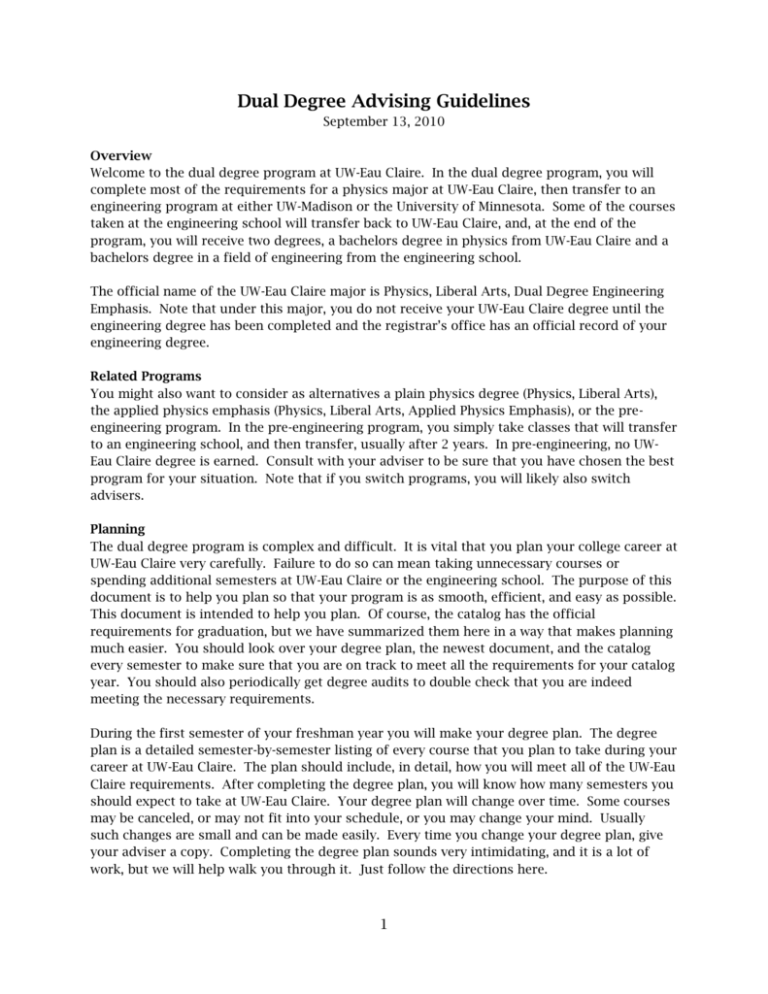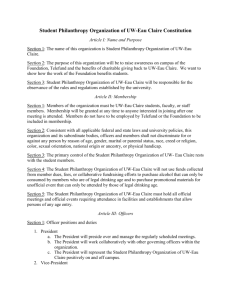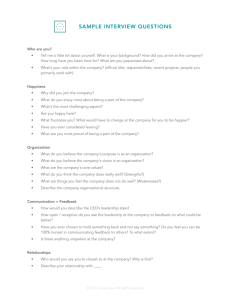Dual Degree Advising Guidelines September 13, 2010 Overview
advertisement

Dual Degree Advising Guidelines September 13, 2010 Overview Welcome to the dual degree program at UW-Eau Claire. In the dual degree program, you will complete most of the requirements for a physics major at UW-Eau Claire, then transfer to an engineering program at either UW-Madison or the University of Minnesota. Some of the courses taken at the engineering school will transfer back to UW-Eau Claire, and, at the end of the program, you will receive two degrees, a bachelors degree in physics from UW-Eau Claire and a bachelors degree in a field of engineering from the engineering school. The official name of the UW-Eau Claire major is Physics, Liberal Arts, Dual Degree Engineering Emphasis. Note that under this major, you do not receive your UW-Eau Claire degree until the engineering degree has been completed and the registrar’s office has an official record of your engineering degree. Related Programs You might also want to consider as alternatives a plain physics degree (Physics, Liberal Arts), the applied physics emphasis (Physics, Liberal Arts, Applied Physics Emphasis), or the preengineering program. In the pre-engineering program, you simply take classes that will transfer to an engineering school, and then transfer, usually after 2 years. In pre-engineering, no UWEau Claire degree is earned. Consult with your adviser to be sure that you have chosen the best program for your situation. Note that if you switch programs, you will likely also switch advisers. Planning The dual degree program is complex and difficult. It is vital that you plan your college career at UW-Eau Claire very carefully. Failure to do so can mean taking unnecessary courses or spending additional semesters at UW-Eau Claire or the engineering school. The purpose of this document is to help you plan so that your program is as smooth, efficient, and easy as possible. This document is intended to help you plan. Of course, the catalog has the official requirements for graduation, but we have summarized them here in a way that makes planning much easier. You should look over your degree plan, the newest document, and the catalog every semester to make sure that you are on track to meet all the requirements for your catalog year. You should also periodically get degree audits to double check that you are indeed meeting the necessary requirements. During the first semester of your freshman year you will make your degree plan. The degree plan is a detailed semester-by-semester listing of every course that you plan to take during your career at UW-Eau Claire. The plan should include, in detail, how you will meet all of the UW-Eau Claire requirements. After completing the degree plan, you will know how many semesters you should expect to take at UW-Eau Claire. Your degree plan will change over time. Some courses may be canceled, or may not fit into your schedule, or you may change your mind. Usually such changes are small and can be made easily. Every time you change your degree plan, give your adviser a copy. Completing the degree plan sounds very intimidating, and it is a lot of work, but we will help walk you through it. Just follow the directions here. 1 The degree plan layout is listed on pages 5 and 6 of this document. The page 5 is a checklist of most of the important requirements you will need to meet: the University requirements, the College of Arts and Sciences requirements for the B.S. degree, and the dual degree emphasis requirements. (It is possible to get a B.A. in the program, but it is almost never done. See your adviser and the catalog if interested.) You will also need to complete a minor. Most students complete a minor in math since they are only 8 credits short after completing their other requirements. Some courses are required by certain engineering schools and engineering majors but not necessarily by UW-Eau Claire. In order to minimize your time in engineering school, consult the Dual Degree Advising Notes section to see what additional courses you should take. The page 6 is a semester-by-semester list of courses you have taken or plan to take at UW-Eau Claire. Filling Out the Degree Plan If you have the Word version of this document, edit pages 5 and 6. On the page 6, list any transfer or AP credits, and fill in any semesters you have completed or are currently taking. Mark on the checklist (page 5) any requirements you have completed. Then, making sure you meet all the requirements listed on the checklist and the advising notes, fill out the courses you will take during your remaining semesters at UW-Eau Claire. We suggest you start with the required math, physics, and other technical courses and fill in the GE requirements around them. Often you can find courses that count in multiple categories. Be sure to list exact courses—not just the GE type. For example, list “ARTH 324 (GE IVA, CD2, FC)” and not just “GE IVA.” As you choose your courses, check the catalog to make sure that you are only listing fall courses in the fall semesters, and spring courses in spring semesters. (Courses offered in the fall generally remain fall courses in later years, and so on.) You may also want to consider taking summer, winterim, or interim courses. Dual Degree Advising Notes Every student must have a minor. The minors that are usually completed by dual degree students are math, chemistry, computational science, foreign language and topical (general minor program designed by student and approved by the Dean of Arts and Sciences). The paperwork for the topical minor must be filled out during the fall of your sophomore year. The plan for your topical minor must be carefully considered to be approved by the Dean. MATH 114, 215, 216 and 312 provide 16 credits toward a math minor. MATH 354 (Introduction to Mathematical Modeling, 4 cr.) and MATH 345 (Introduction to Probability and Mathematical Statistics, 4 cr.) together enable you to finish the math minor. (They are also excellent courses for engineering majors to take.) Note that MATH 345 is now a Fall only course, and MATH 354 is a Spring only course. Students need to take 12 credits of 325 level or above physics courses at UW-Eau Claire. PHYS 332, PHYS 340, and PHYS 350 add up to eleven credits. Depending on the engineering school and the engineering program PHYS 365 or PHYS 360 are excellent ways to finish up that requirement. LabVIEW Basics (PHY 495) is another way to complete the requirement. 2 As a general rule, civil, mechanical, engineering mechanics, and aerospace engineers should take MATH 255 (Statics) and MATH 256 (Dynamics) instead of PHYS 365. UW-Madison specific notes All engineering fields: take either CHEM 115 or both CHEM 103 and CHEM 104. Madison’s EPD 397 is a technical writing course effectively required in most engineering disciplines. EPD 397 transfers back to UW-Eau Claire as a 300 level GE 1A (English 305). Be sure you choose your UW-Eau Claire GE courses to meet UW-Madison’s Liberal Electives requirements. Also note that students transferring to UW-Madison will need a letter of recommendation from a faculty member in the sciences or mathematics who has taught you in a class. Have your recommender e-mail the letter to your advisor by December (if transferring in the fall of the following year) or by April (if transferring in the spring of the following year). Chemical: Chemical engineering is extremely difficult (but not impossible) to do with the dual degree program since it has less overlap with physics and math courses. See your adviser. Civil: take Statics (MATH 255) and Dynamics (MATH 256). In general, do NOT take CS 163. Instead take CEE 291 at Madison. It will transfer back and fulfill the computing requirement of the dual-degree program. You will need to fill out course substitution paperwork before leaving UW-Eau Claire. Our MATH 345 counts for Madison’s STAT 324, which is a required course in their program. Electrical: take CS 163, take PHYS 360 (talk to your advisor for more details) Our PHYS 350 & 360 together count as ECE 230, ECE 340, ECE 170 and ECE 270 at Madison for Electrical Engineers. MATH 346 will count for the Madison’s Stat 311 requirement, MATH 345 will not. The UW-Madison transfer adviser encourages students to take STAT 311 at Madison, however. (If you are a math minor, you may not want to take MATH 345.) Engineering Mechanics: take Statics (MATH 255) and Dynamics (MATH 256), take CS 163, Our PHYS 350 counts as ECE 376. Engineering Mechanics requires separate differential equations and linear algebra courses. You may take our Math 311 (Differential Equations) and our Math 324 (Linear Algebra and Matrix Theory) to meet this requirement. If you take both, the physics department will waive the requirement for Math 312, our combined differential equations and linear algebra course. However, be aware that Math 311 is not offered very often. You may take differential equations (Madison’s Math 319) at Madison, and it will transfer back as 3 math credits. Our Math 312 will count as Madison’s linear algebra course. However, because of overlap, you cannot count both Math 312 and a differential equations course toward the UW-Eau Claire math minor. Engineering Mechanics requires only one technical elective, and our Optics course satisfies it. Materials: take CS 163 3 Our PHYS 350 counts as ECE 376. Organic Chemistry 1 with Laboratory I (CHEM 325) is also required. Mechanical: take Statics (MATH 255) and Dynamics (MATH 256), take CS 163 Our PHYS 350 counts as ECE 376. Our MATH 351 (Numerical Analysis I) counts as a technical elective. Nuclear: take Statics (MATH 255) and Dynamics (MATH 256), take CS 163, Our PHYS 350 counts as ECE 376. See you adviser regarding math classes. Any other fields: see Tips for Transfers and your adviser. University of Minnesota specific notes All engineering fields: PHYS 350 and PHYS 360 together count as Minnesota’s EE 3005 and EE 3006, most fields require only CHEM 103. Aerospace: take Statics (MATH 255) and Dynamics (MATH 256), take CS 163, take PHYS 360 Chemical: Chemical engineering is extremely difficult (but not impossible) to do with the dual-degree program since it has less overlap with physics and math courses. See your adviser. Civil: take Statics (MATH 255) and Dynamics (MATH 256), take CHEM 103 and CHEM 104 (or just take CHEM 115), take CS 170 instead of CS 163 Electrical: take CS 163, take PHYS 360 if possible (talk to your advisor for more details) Materials: take CS 163, take CHEM 103 and CHEM 104 (or just take CHEM 115). Organic Chemistry 1 with Laboratory I (CHEM 325) is also required. It is suggested that students try to pick up Minnesota’s AEM 3031 in the summer prior to entry into the Institute of Technology. Mechanical: take Statics (MATH 255) and Dynamics (MATH 256), take CS 163, take PHYS360. IE 4521 (4 cr) will transfer back to UW-Eau Claire as MATH 345 for the purposes of the math minor. Any other fields: talk with your adviser and see the University of Minnesota Transfer Plan. After Transferring After transferring to engineering school, you should do the following. 1. Regularly check your UW-Eau Claire e-mail. It’s the only way your adviser has to let you know of changes to the program. 2. E-mail your UW-Eau Claire adviser at least once a semester. Inform your adviser of any problems. Also inform your adviser a semester and a half before you graduate. 4 3. During your next-to-final semester, send an official transcript from your engineering school to the UW-Eau Claire registrar’s office. Don’t wait for your grades. 4. Before registering for your last semester of engineering school, run a UW-Eau Claire degree audit. Make sure that the courses you are taking in your final semester will finish up any unfulfilled UW-Eau Claire requirements. 5. Apply for graduation at UW-Eau Claire near the end your next-to-final semester. So if you plan to graduate in spring, apply for graduation near the end of the previous fall semester. 6. After graduating from engineering school, send a final official transcript to the UW-Eau Claire registrar’s office. You cannot receive your UW-Eau Claire degree until your engineering degree is officially on record at the UW-Eau Claire registrar’s office. 7. Inform your adviser after you have graduated! Transferring Back Courses The following are engineering courses that will transfer back to UW-Eau Claire to count as upper division (300 level or above) electives to satisfy the UW-Eau Claire Dual Degree Engineering Emphasis requirements. Courses at the University of Wisconsin – Madison: CEE 310 (3 cr), CEE 340 (4 cr), CEE 316 (3 cr), CEE 395 (3 cr), CEE 440 (3 cr) ECE 301 (1 cr), ECE 305 (1 cr), ECE 304 (1 cr), ECE 310 (1 cr), ECE 306 (1 cr), ECE 308 (1 cr), ECE 317 (1 cr), ECE 320 (3 cr), ECE 345 (3 cr), ECE 376 (3 cr), ECE 431 (3 cr) EMA 303 (3 cr), EMA 307 (1 cr), EMA 521 (3 cr) ISyE 320 (3 cr), ISyE 321 (1 cr), ISyE 323 (3 cr), ISyE 415 (3 cr) ME 306 (3 cr), ME 307 (1 cr), ME 340 (3 cr), ME 346 (3 cr), ME 361 (3 cr), ME 363 (3 cr), ME 364 (3 cr), ME 368 (3 cr), ME 409 (4 cr), ME 463 (3 cr), ME 470 (3 cr) MS&E 350 (3 cr), MS&E 351 (3 cr) Courses at the University of Minnesota - Twin Cities: AEM 3031 (3 cr), AEM 4201 (4 cr), AEM 4202 (4 cr), AEM 4203 (4 cr), AEM 4301 (3 cr), AEM 4303 (3 cr), AEM 4311 (4 cr), AEM 4511 (3 cr), AEM 4581 (3 cr), AEM 4601 (3 cr), AEM 4602 (4 cr) CE 3401 (3 cr), CE 3402 (3 cr), CE 3502 (4 cr), CE 4401 (3 cr) EE 3015 (3 cr), EE 3101 (2 cr), EE 3102 (2 cr), EE 3105 (0.75 cr), EE 3115 (4 cr), EE 3161 (3 cr), EE 3165 (3 cr), EE 3601 (3 cr), EE 4111 (4 cr), EE 4231 (3 cr) ME 3221 (4 cr), ME 3222 (4 cr), ME 3281 (4 cr), ME 3321 (4 cr), ME 3322 (4 cr), ME 5223 (4 cr), ME 5241 (4 cr) 5 Degree Plan Name: UW-Eau Claire E-mail: Engineering School: Engineering Field: Date (Last Update of Degree Plan): Requirement PHYS 231 University Physics I (F, Sp) PHYS 232 University Physics II (F, Sp) PHYS 332 University Physics III (F, Sp) PHYS 340 Optics (Sp) PHYS 350 Electric and Electronic Circuits (F) PHYS 365 Theoretical Mechanics (F) or MATH 255 Statics (F) and MATH 256 Dynamics (Sp) MATH 255 and 256 are each 3 cr courses. Together they count as 4 cr in the dual degree program. 12 Credits of 325 level or above physics courses at taken at UW-EC 11 Additional credits of upper division physics (see catalog—usually completed at engineering school) MATH 114 Calculus I (F, Sp) MATH 215 Calculus II (F, Sp) MATH 216 Calculus III (F, Sp) MATH 312 Differential Equations and Linear Algebra ENG 110 College Writing (F, Sp) Physical Activity Wellness Theory CS 163 C++ (F, Sp) (CS 170 for some programs) or Madison CS 310 for Civil Eng CHEM 103 (F, Sp) (and CHEM 104 for certain programs), or CHEM 115 Cultural Diversity Foreign Language/Culture -foreign lang. placement test score that qualifies student to enter a 201 level course or -completing a 102 level foreign lang. course with a grade of C or above or mark of S or -earning credit in a 101 or 102 level foreign lang. course AND earning at least 6 cr of FC courses or -one full semester study abroad or -9 cr of FC courses General Education Requirements (need 45 cr total) GE I Communications GEIA Language Skills (CJ 201, 202, Foreign Lang) GEIB Analytical Skills (CS 163, MATH 114) GEII Natural Science (PHYS 231, PHYS 232, CHEM 103) GE III Social Science (2 of 7 subcategories) GE IV Humanities (2 of 5 sub categories) GE V University Wide General Education 300 level or above cr in any courses (Note: often completed at engineering school) 300 level or above GE cr in 2 of 5 GE categories Minor requirements. (For students earning the math minor, 8 credits of MATH courses labeled 310 or higher in addition to MATH 312 are required.) Service Learning 6 Cr 5 5 3 4 4 4 12 11 4 4 4 4 5 1 1 3 5 3 6 3 9 ? 9 45 6-9 3-6 3-6 15 9-12 9-12 0-6 39 9 8 30 hr Semester listed in degree plan Semester successfully completed Degree Plan (continued) Name: Date (Last Update of Degree Plan): Transfer, AP courses Course Description + GE Category if applicable Cr Semester: Course Description + GE Category if applicable Cr Semester: Course Description + GE Category if applicable Cr Semester: Course Description + GE Category if applicable Cr Semester: Course Description + GE Category if applicable Cr Semester: Course Description + GE Category if applicable Cr Semester: Course Description + GE Category if applicable Cr Courses still needed after transferring to eng. school Course Description + GE Category if applicable Cr Notes: 7





